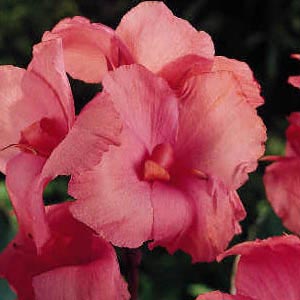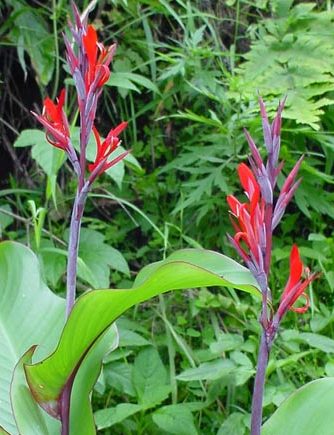
Cannas
Introduction:
One of the most important perennial flowering plant which is grown abundantly in the humid tropical regions throughout the world is the Cannas. They are very hardy and thus grown easily and successfully. The flowers have many shades of colour. The flowers bloom throughout the year and make a wonderful display of colour which can hardly be surpassed by any other perennial plant.
Cannas are frequently grown in private gardens but more extensively in the public gardens.
The genus Canna has about 50 species, native of Tropical America and
1. Canna Indica (Indian shot)
Rhizome stout, stem slender green 1 to 1.2 m high. Leaves oblong 45-60 cm long green, flower in simple raceme or in pairs; sepals-short, waxy; petals-pale pink, lanceolate; staminodes 3 red or rose about 5 cm long.
2. Canna Flaccida
Stem rather slender, 1.2 to 2 m high. Leaves ovate-lanceolate 20-30 cm long. Flowers few flowered raceme, pale yellow to sulphur; sepals-small; petals-linear-lanceolate, up to 7 cm long; staminodes-3 about 7 cm long.
3. Canna Lutea
Stem green 1 to 1.2 meters high. Leaves oblong or
broadlanceolate, 25-40 cm long. Flowers on simple
raceme pale yellow; sepals-oblong green white
margined; petals-lanceolate pale yellowish white;
staminodes pale yellow.
Canna is a rhizomatous plant and is very easily propagated by dividing
the rhizomes into 10-15 cm pieces during end of June.
Classification: -
A lot of research and hybridation of the canna has been undertaken during the last 4 decadesand as a result large number of varieties have been developed. Depending on the size and shape of the flowers, cannas have been classified as follows:
· Alipore Hybrids:
The selections are the results of 45 years of hybridisation and are a great improvement on the crozy types from which they are derived. The size of the flowers markedly increased with a wide range of colour.
· Bouquet:
In this class an ideal variety ‘cupid’ has flowers on closely branched spikes. The plants of this variety are dwarf.
Candleabra:
This is a distinct break. The main flower stalk branches and as many as 8-12 spikes are produced instead or two or three.
· Crozy and gladiolus flower:
These are improved hybrids raised by Anne in about 1850 and Vilmorin in 1880.
· Dreadnaught:
A great advance on the ordinary crozy or gladiolous flowered canna both as regards the individual flowers and bunches.
· Dwarf:
This type include varieties which does not exceed the height of 70-80 cm at any time of the year and are very effective for breeding purpose.
· Giant or Orchid flower:
Originated in
· Miniature:
This is small flowering type derived by crossing a society’s dwarf hybrid with Canna indica. The spikes are neat and compact.
Cannas can also be divided into several classes according to the colour of the flowers.
1. Selfs: - without spots or margin, one colour only.
2. Spotted: -usually a shade of red on cream or yellow ground or red spots on orange of red ground.
3. Striped red on a cream or a yellow ground.
4. Margin yellow.
5. Margined with a darker shade than the ground colour.
6. Flaked red or orange on a paler ground.
7. Splashed orange on a deeper ground.
The shades of colour cover a wide range from creamy white through yellow, orange and pink to an intense maroon red.
Propagation:
Canna is commonly propagated by rhizome. Seeds are used for raising new varieties through hybridisation. The seeds have hard seed coat and take a long time to germinate, if the seeds are not treated with hot water or rubbed on a sandpaper.
New varieties result by hybridization. For this purpose they are raised from seeds. Bud sports also produce new varieties. The seeds are of a small pea size and black in colour with a hard seed coat. The seeds are scarified by filing, or by rubbing with a sandpaper or a small portion cut off with a sharp razor blade without injuring the embryo which is inside the seed. This treatment ensures the better germination of seeds. Sometimes, soaking of seeds into water overnight or keeping them in cowdung before sowing is also useful obtaining better germination.
Cultivation:
· The rhizomes are collected in the month of May and then planted to get the full benefit of the Monsoon and a strong clump forms before the winter.
· The soil is prepared by digging at least 50 cm deep, breaking the clods and mixing in fresh stable manure at the rate of 100 kg to a bed of 10 sq. metre.
· The rhizomes are buried 3 cm below the surface of the soil and thoroughly flooded. If the weather is hot and dry, shade is provided for a few days. Planting is done at a distance of 30-40 cm between the rows and the plant.
· Within six weeks after planting first flower spikes appear which should be removed in order to encourage better growth.
· The bed should be kept free from weeds by frequent weeding.
· After the rain ceases and the soil thoroughly dries, it is loosened and allowed to dry. Digging and watering of the bed are necessary at least once a month in the winter and more frequent flooding is recommended to keep the soil moist.
· After the first flush of flowering is finished in December, leaf-mould or cowdung manure should be applied to the beds to ensure good flowering in the second flush from April to June.
Canna is replanted every year. The rhizome is lifted with a forked hoe, cleaned properly and the top growth cut leaving a stem of about 15 cm. The clump is then split taking only the strongest: root and stored in a shady place for a week or so before replanting. The canna beds should be kept clean by collecting faded flowers and removing dry leaves.
Cannas can also be grown in 30-35 cm pot and the compost should consist of 2 parts stable manure and 1 part garden soil. The potted plants should be replanted every 6-9 months as the roots become pot bound.
Pests and Diseases
Cannas are hardy plants and are particularly free of diseases. Caterpillars occasionally attack the leaves specially during the rainy seasons and bettles sometime destroy the flowers. Application of insecticides like Malathion, Basudin, etc. will keep away the insects.
Some of the most important varieties are given below:
|
Ser No |
Name of the Variety |
Flower Colour |
|
1 |
American Beauty |
|
|
2 |
Apricot |
Buff-yellow base overspread with salmon pink. |
|
3 |
Aurora Borealis |
Canary-yellow with rose pink centre, beautifully rayed. |
|
4 |
Carmine king |
Bright carmine-red with yellow centre |
|
5 |
Cleopatra |
Orange terracotta, Light purple leaves |
|
6 |
Dorris |
Pale salmon-pink Flowers very pretty. |
|
7 |
Golden Wedding |
Yellow |
|
8 |
Louis Cayeux |
Large flowers with bright rosy scarlet colour. |
|
9 |
Mrs Herbert Hoover |
Beautiful flowers with deep watermelon pink colour |
|
10 |
Mrs Pierre S.du Pont |
Very charming flowers with crinkled edges and light watermelon pink colouration. |
|
11 |
Rosamond Coles |
Dark reddish-orange with deep orange yellow border. |
|
12 |
Rosea gigantea |
Very large flowers with soft rose to carmine-pink colour. |
|
13 |
Statue of |
Plants with bronze coloured leaves and blazing flame-red flowers. |
|
14 |
Susquehana |
Dwarf plants with rose-pink flowers. |
|
15 |
The President |
Beautiful large flowers with rich growing scarlet colour. |
|
16 |
Yellow King Humbert |
Bi-coloured flowers. Bright yellow petals marked with crimson dots. |


